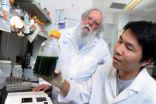(Press-News.org) BOSTON--Flipping a newly discovered molecular switch in white fat cells enabled mice to eat a high-calorie diet without becoming obese or developing the inflammation that causes insulin resistance, report scientists from Dana-Farber Cancer Institute.
The researchers say the results, to be published in the Sept. 28 issue of the journal Cell, provide the first known molecular link between thermogenesis (burning calories to produce heat) and the development of inflammation in fat cells.
These two processes had been previously thought to be controlled separately. Thermogenesis plays an important role in metabolism and maintaining healthy weight. Inflammation triggers insulin resistance, a precursor of diabetes.
The researchers, led by Bruce Spiegelman, PhD, found that the protein TRPV4, a switch molecule, is highly expressed in white fat cells, which store excess calories and become engorged in obese individuals.
For this study, the investigators bred mice lacking TRPV4 or administered a drug to deactivate it. In the absence of TRPV4, white cells turned on a set of genes that consume energy to produce heat, rather than storing the energy as excess fat. This "thermogenic" process normally occurs in brown or beige fat (commonly called "good fat"), which is found mostly in small animals and human infants to protect against cold.
When the TRPV4-deficient mice were put on a high-calorie diet for several weeks, they did not become obese, and their level of fat cell inflammation and insulin resistance was lowered.
"We have identified a target that, when inhibited, can activate beige adipose tissue and suppress inflammation," said Spiegelman. "This role of TRPV4 as a mediator for both the thermogenic and pro-inflammatory programs in adipocytes, or fat cells, could offer an attractive target for treating obesity and related metabolic diseases."
A co-activator protein, PGC-1 alpha, previously discovered in the Spiegelman laboratory, helps turn on thermogenesis to produce heat. In the new experiments, Spiegelman and his colleagues demonstrated that TRPV4 blocks PGC-1 alpha in white fat cells. Inhibiting TRPV4 in the experimental mice raised the expression of PGC-1 alpha and sparked thermogenesis.
An experimental compound, GSK205, was used to inhibit TRPV4 in the animal studies. Spiegelman said that this technology has been licensed for further development to Ember Therapeutics, a company he co-founded. Spiegelman is an Ember consultant and shareholder.
In terms of potential therapies, Spiegelman said that "any single new approach to something as complicated as metabolic disease is unlikely to work, but our experiments with TRPV4 showed the effectiveness of this strategy and it appears to be quite safe."
INFORMATION:
The first author of the report is Li Ye, PhD, in the Spiegelman lab. Other authors are from Dana-Farber, Boston Children's Hospital, The Scripps Research Institute, Jupiter, Fla., Duke University Medical Center, Durham, N.C., and Massachusetts General Hospital.
The research was supported in part by National Institutes of Health grants (DK031405 and DK080261).
Dana-Farber Cancer Institute is a principal teaching affiliate of the Harvard Medical School and is among the leading cancer research and care centers in the United States. It is a founding member of the Dana-Farber/Harvard Cancer Center (DF/HCC), designated a comprehensive cancer center by the National Cancer Institute. It provides adult care with Brigham and Women's Hospital as Dana-Farber/Brigham and Women's Cancer Center, and it provides pediatric care with Boston Children's Hospital as Dana-Farber/Children's Hospital Cancer Center. Dana-Farber is the top-ranked cancer center in New England, according to U.S. News & World Report, and one of the largest recipients among independent hospitals of National Cancer Institute and National Institutes of Health grant funding. Follow Dana-Farber on Twitter: @dana-farber or Facebook: facebook.com/danafarbercancerinstitute.
Scientists find molecular link to obesity and insulin resistance in mice
Switch that 'browns' white fat could lead to new therapies
2012-09-27
ELSE PRESS RELEASES FROM THIS DATE:
Canadian science and technology is healthy and growing, says expert panel
2012-09-27
AUDIO:
An authoritative, evidence-based assessment of the state of science and technology in Canada has found that Canadian science and technology is healthy, growing and internationally respected. Over the past five...
Click here for more information.
Ottawa (September 27th, 2012) - An authoritative, evidence-based assessment of the state of science and technology in Canada has found that Canadian science and technology is healthy, growing and internationally respected. Over ...
Shared pathway links Lou Gehrig's disease with spinal muscular atrophy
2012-09-27
Researchers of motor neuron diseases have long had a hunch that two fatal diseases, amyotrophic lateral sclerosis (ALS) and spinal muscular atrophy (SMA), might somehow be linked. A new study confirms that this link exists.
"Our study is the first to link the two diseases on a molecular level in human cells," said Robin Reed, Harvard Medical School professor of cell biology and lead investigator of the study.
The results will be published online in the September 27 issue of Cell Reports.
ALS, or Lou Gehrig's disease, which has an adult onset, affects neurons that ...
Major cancer protein amplifies global gene expression, NIH study finds
2012-09-27
Scientists may have discovered why a protein called MYC can provoke a variety of cancers. Like many proteins associated with cancer, MYC helps regulate cell growth. A study carried out by researchers at the National Institutes of Health and colleagues found that, unlike many other cell growth regulators, MYC does not turn genes on or off, but instead boosts the expression of genes that are already turned on.
These findings, which will be published in Cell on Sept. 28, could lead to new therapeutic strategies for some cancers.
"We carried out a highly sophisticated ...
Obesity-related hormone discovered in fruit flies
2012-09-27
Researchers have discovered in fruit flies a key metabolic hormone thought to be the exclusive property of vertebrates. The hormone, leptin, is a nutrient sensor, regulating energy intake and output and ultimately controlling appetite. As such, it is of keen interest to researchers investigating obesity and diabetes on the molecular level. But until now, complex mammals such as mice have been the only models for investigating the mechanisms of this critical hormone. These new findings suggest that fruit flies can provide significant insights into the molecular underpinnings ...
Aggressive cancer exploits MYC oncogene to amplify global gene activity
2012-09-27
CAMBRIDGE, Mass. (September 27, 2012) – For a cancer patient, over-expression of the MYC oncogene is a bad omen.
Scientists have long known that in tumor cells, elevated levels of MYC's protein product, c-Myc, are associated with poor clinical outcomes, including increased rates of metastasis, recurrence, and mortality. Yet decades of research producing thousands of scientific papers on the subject have failed to consistently explain precisely how c-Myc exerts its effects across a broad range of cancer types. Until now, that is.
The prevailing theory emerging from ...
Landmark guidelines for optimal quality care of geriatric surgical patients just released
2012-09-27
Chicago (September 27, 2012)—New comprehensive guidelines for the pre- operative care of the nation's elderly patients have been issued by the American College of Surgeons (ACS) and the American Geriatrics Society (AGS). The joint guidelines—published in the October issue of the Journal of the American College of Surgeons—apply to every patient who is 65 years and older as defined by Medicare regulations. The guidelines are the culmination of two years of research and analysis by a multidisciplinary expert panel representing the ACS and AGS, as well as by expert representatives ...
Uptick in cinematic smoking
2012-09-27
Top box office films last year showed more onscreen smoking than the prior year, reversing five years of steady progress in reducing tobacco imagery in movies, according to a new UCSF study.
Moreover, many of the top-grossing films of 2011 with significant amounts of smoking targeted a young audience, among them the PG-rated cartoon Rango and X-Men: First Class." The more smoking young people see in movies, the more likely they are to start smoking, the U.S. Surgeon General has reported.
The study will be available September 27, 2012 in Preventing Chronic Disease Journal, ...
Breakthrough in kitchen furniture production: Biocomposites challenge chipboard
2012-09-27
Biocomposites challenge chipboard as furniture material. Researchers at VTT Technical Research Centre of Finland have developed a kitchen furniture framework material from plastic polymers reinforced with natural fibre. The new material reduces raw materials consumption by 25 per cent and the carbon footprint of production by 35 per cent.
"The frames are lighter by nearly a third because they contain more air," says VTT's Research Professor Ali Harlin. "Wastage during production is also reduced. This is a generational shift that revolutionizes both manufacturing techniques ...
Breakthrough for new diabetes treatment
2012-09-27
In experiments on mice and rats, the scientists have managed to both prevent the development of type II diabetes and reverse the progression of established disease. The study is published in the prestigious scientific journal Nature, where it is described as a breakthrough in diabetes research. The findings are the result of a joint effort by Karolinska Institutet, the Ludwig Institute for Cancer Research and the Australian biopharmaceutical company CSL Limited, amongst others.
"It's a great feeling to present these results," says Professor Ulf Eriksson of the Department ...
ASU scientists bring the heat to refine renewable biofuel production
2012-09-27
TEMPE, Ariz.-Perhaps inspired by Arizona's blazing summers, Arizona State University scientists have developed a new method that relies on heat to improve the yield and lower the costs of high-energy biofuels production, making renewable energy production more of an everyday reality.
ASU has been at the forefront of algal research for renewable energy production. Since 2007, with support from federal, state and industry funding, ASU has spearheaded several projects that utilize photosynthetic microbes, called cyanobacteria, as a potential new source of renewable, carbon-neutral ...
LAST 30 PRESS RELEASES:
HKUST Engineering researchers developed a novel photodetector to enhance the performance of on-chip light monitoring
Strategic river sensors could have forewarned of Texas Camp flood disaster
Drone sampling of whale breath reveals first evidence of potentially deadly virus in Arctic
Roman soldiers defending Hadrian’s Wall infected by parasites, study finds
Pinochet’s prisoners were tormented with music but still found solace in it, a new book reveals
Fertility remains high in rural Tanzania despite access to family planning
AI-assisted device can improve autism care access
Kinetic careers
Uncovering how parasitic plants avoid attacking themselves to improve crop resistance
Nanoparticle vaccine strategy could protect against Ebola and other deadly filoviruses
Study finds brain care score can predict risk of stroke across racial groups
Key lung immune cells can intensify allergic reactions
Do hormones explain why women experience more gut pain?
New materials conduct ions in solids as easily as in liquids
Breakthrough of the Year: Renewable energy begins to eclipse fossil fuel-based sources
LLM use is reshaping scientific enterprise by increasing output, reducing quality and more
Introducing LightGen, a chip for ultra-fast, ultra-efficient generative AI
Astronomers see fireworks from violent collisions around nearby star
ACC/AHA issue new guideline on managing congenital heart disease in adults
Cosmic crash caught on camera
Is talented youth nurtured the wrong way? New study shows: top performers develop differently than assumed
Ants: An untapped resource in the development of antibiotics?
Archaeologists use AI to create prehistoric video game
Mitochondria migrate toward the cell membrane in response to high glucose levels
Tiny viral switch offers hope against drug-resistant bacteria
Most parents aware of early peanut introduction guidelines, but confused about details
HPV vaccine can protect against severe lesions of the vulva and vagina
Virtual care provision and emergency department use among children and youth
Quadrivalent HPV vaccine and high-grade vulvovaginal lesions
Insights into dry eyes gained from stem cell-derived tear glands
[Press-News.org] Scientists find molecular link to obesity and insulin resistance in miceSwitch that 'browns' white fat could lead to new therapies


